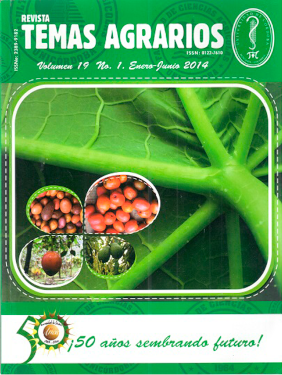Simultaneous biosorption of lead and cadmium from aqueos solution by fungal biomass Penicillium sp.
Biosorción simultanea de plomo y cadmio en solución acuosa por biomasa de hongos penicillium sp.

This work is licensed under a Creative Commons Attribution-NonCommercial 4.0 International License.
Show authors biography
The discharge of metals in the environment generates significant impacts on human health and the life cycles of living organisms. Some microorganisms are known for their high adsorption capacity for metals, including fungi. The aim of this study was to evaluate the remotion capacity of Pb (II) and Cd (II) in aqueous solutions with Penicillium sp. fungi, isolating the soil fungal strain of the Alacrán Mine (Cordoba-Colombia) and determining the influence of the removal on the variables pH, metal concentration and temperature, analyzing the Langmuir and Freundlich isotherms, verifying the functional groups involved in the adsorption by infrared analysis (IR)., to potential their use in wastewater treatment. Analyses were conducted using Thermo Scientific equipment, atomic absorption ICE model 3000 Series and FT- IR Nicolet IS5 spectrophotometer. Quality control was performed for metal analysis with reference material SRM 1643e. The results indicate that to the concentration of 51.5 mg L-1 showed higher removal percentages for 0.5 g of biomass. The maximum adsorption occurred at acidic pH (4-5), 60 °C and 2g of biomass, achieving removals of 92.4 % for Pb and 80% for Cd. Isotherm analyzes best fit the model Langmuir. IR analysis shows -OH, -NH, C-N, C-H, N-H, C=O, amide I and amide II and polysaccharides, attributing this attraction in metals and fungal biomass.
Article visits 1713 | PDF visits
Downloads
- Agarwal, G., Bhuptawat, H. and Chaudhari, S. 2006. Biosorption of aqueous chromium (VI) by tamarindus indica seeds. Bioresource Technology. 97: 949-956.
- Deng, L., Su, Y., Su, H., Wang, X. and Zhu, X. 2006. Biosorption of copper(II) and lead(II) from aqueous solutions by nonliving green algae Cladophora f ascicularis: equilibrium, kinetics and environmental effects. Adsorption. 2: 267-277.
- Deng, S. and Ting, P. 2005. Characterization of PEI-modified biomass and Biosorption Cu(II), Pb(II) and Ni(II). Water Research 39: 2167-2177.
- Fan, T., Liu, Y., Feng, B., Zeng, G., Yang, C. and Zhou, M. 2008. Biosorption of cadmium (II), zinc (II) and lead (II) by Penicillium simplicissimum: Isotherms, kinetics and thermodynamics. Journal Of Hazardous Materials. 160: 655-661.
- Gupta, V. and Rastogi, A. 2008. Biosorption of lead from aqueous solutions by green algae Spirogyra species: kinetics and equilibrium studies. Journal Of Hazardous Materials. 152: 407-414.
- Johannes, F., Grosse, C., Esche, V., Brandenburg, P., Reich, A. and Groneberg, D. 2006. The toxicity of cadmium and resulting hazards for human health.Journal of Occupational Medicine and Toxicology. 1: 1-6.
- Lin, L., Li, J. and Juang, R. 2008. Removal of Cu(II) and Ni(II) from aqueous solutions using batch and fixed-bed ion exchange processes. Desalination. 225: 249-259.
- Miller, J., y Miller, J. 2002. Exactitud. In Estadística y Quimiometría para Química Analítica. Prentice Hall, Madrid. p277-278.
- Mishra, S. and Roy, C. 1996. Kinetics of Zn+2 adsorption by Pencillium sp. Hydrometallurgy. 40: 11-23.
- Natarajan, V., Grim, H., Muthuswamy, S., Tae, C., Kui, L. and Byung, O. 2010. Isolation, identification, Pb (II) biosorption isotherms and kinetics of a lead adsorbing Penicillium sp. MRF-1 from South Korean mine soil. Journal Of Environmental Sciences-China. 7: 1049-1056.
- Pino, G., Mesquita, L. and Torem, M. 2006. Biosorption of heavy metals by powder of green coconut shell. Separation Science And Technology. 41: 3141-3153.
- Shringer, R., Hermann, C., Morrill, T., Curtin, D. and Fuson, R. 1998. The Systematic Identification of Organic Compounds. Wiley, New York. 324 p.
- Valencia, H. 2004. Cultivo, microcultivo e identificación de hongos. Manual de prácticas de microbiología básica. Facultad de Ciencias de la Universidad Nacional de Colombia, Bogotá. p99-116
- Volesky, B. and Holan, Z. 1995. Biosorption of heavy metals.Biotechnology Progress. 11: 235-250
- Yan, G. and Viraraghavan, T. 2003. Heavy metal removal from aqueous solution by fungus Mucorrouxii.Water Research. 37: 4486-4496.
- Yi,L. and Shui, C. 2011. The biosorption of heavy metals from aqueous solution by Spirogyraand Cladophora filamentous macroalgae. Bioresource Technology. 102: 5297-5304.




















